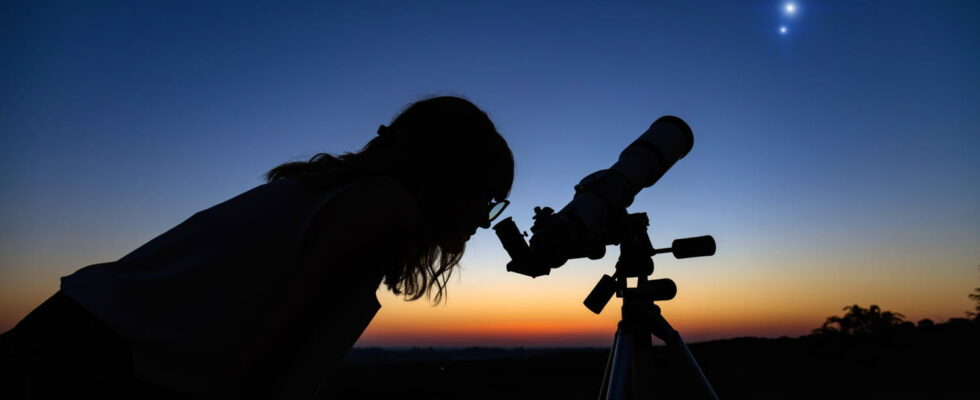CONJUNCTION VENUS JUPITER. This Thursday evening, March 2, the rapprochement between the planets Venus and Jupiter is still visible to the naked eye or using a telescope. Under what conditions of observation and at what time?
[Mis à jour le 2 mars 2023 à 19h09] The spectacular rapprochement between Venus and Jupiter, at an apparent distance equivalent to the diameter of the moon’s disk, will light up the night sky this Thursday, March 2, for the last time. Go out at nightfall far from any light pollution, and observe the sky towards the western horizon. These two stars, although several hundred million kilometers apart, appear simultaneously in the field of vision of a pair of binoculars or a telescope.
Great views of Jupiter and Venus in the next week! Don’t miss them, look west after sunset… they won’t be this close again until ~May 2024
Image credit: John Jardine Goss/EarthSky pic.twitter.com/l1w1O0vi1c
— Dr. James O’Donoghue (@physicsJ) February 24, 2023
This conjunction is particularly spectacular since the two planets Venus and Jupiter are currently among the brightest stars in the sky. It is an important meeting place for the curious and astronomy enthusiasts. How not to miss anything of the show? What equipment should be favored to admire the conjunction? Here’s everything you need to know about this celestial rapprochement.
When does the Venus-Jupiter conjunction take place?
The conjunction between the planets Venus and Jupiter is visible from Wednesday 1er to Thursday March 2, 2023 at the end of the day at dusk. This celestial ballet will not last forever since the two planets will disappear behind the horizon around 9 p.m., which will leave just over two hours to admire them in the night sky.
What is the Venus-Jupiter conjunction?
The conjunction of two planets is a phenomenon that occurs when these two stars come together in the sky when observed from a third object, usually the Earth. We then have the impression that the two planets are close to each other. But this rapprochement is only visual, since in reality the latter can be several billion kilometers from each other and appear side by side in the sky.
This phenomenon occurs relatively frequently but remains spectacular since it is an opportunity to admire the two stars simultaneously. Conjunctions can involve planets but also other celestial objects such as asteroids, moons or stars.
Wednesday 1er and Thursday, March 2, 2023, you can admire the conjunction of Venus, nicknamed the Evening Star, and Jupiter, the largest planet in the solar system. The two planets are particularly bright and appear side by side in the sky once the sun layer.
What is the distance between Venus and Jupiter?
At conjunction, Venus and Jupiter are visible very close to each other in the sky. But make no mistake, these two planets are relatively far apart in the solar system since more than 670 million kilometers separate them. For comparison, this represents more than four times the distance that separates us from the Sun. Between Venus and Jupiter lies the main asteroid belt and the orbit of the planet Mars.
Both planets are so bright that the spectacle is visible to the naked eye. You can also use an optical device such as a telescope or a pair of binoculars. This allows you to observe the two bright stars more distinctly.
Venus and Jupiter appear in the constellation Pisces when the sun sets. Both planets are then visible above the western horizon. To take full advantage of the event, choose a clear area. You can then watch this duo evolve in the sky until it disappears behind the horizon around 9 p.m.
To locate the planets, you can consult an online sky map like the one on the site Stelvision or even a smartphone application like Sky Tonight (on Google Play Or App Store). Venus is easily recognizable by its strong luminosity. You then see a second particularly bright star at its side: Jupiter.
